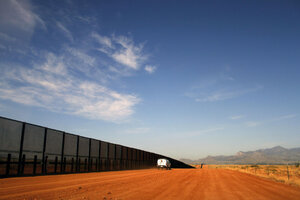Will US extension of National Guard border presence deter immigration from Mexico?
The decision to keep Guard troops along the US-Mexico border until the end of the year comes amid a 40-year low in Border Patrol arrests and a 60 percent drop in Mexican immigration since 2006.

A US Border vehicle drives along the US and Mexico border fence in Naco, Arizona September 7, 2011. Since the attacks on 9/11 ten years ago, the US Border Patrol and National Guard Troops have increased security along the border in Arizona. Picture taken September 7.
Joshua Lott /Reuters
Phoenix, Arizona
Although the Obama administration has repeatedly declared the US-Mexico border safer than it’s ever been, it has decided that the deployment of 1,200 National Guard troops stationed along the international line will stay on through the end of the year. The troops were previously scheduled to leave on Sept. 30.
It’s no surprise the announcement came just before the tenth anniversary of 9/11. The terrorist attack forever changed how Americans view border security and many of the immigrants who come to this country, both legally and illegally.
In the midst of an unprecedented border build-up of manpower and infrastructure over the past decade, Arizona emerged as a leading voice in the crusade linking terrorism, border security, and immigration. A state law aimed at ousting illegal immigrants from the state kept Republican Governor Jan Brewer in office and on the national stage.
Often at odds with the Obama administration, which is challenging the constitutionality of Arizona’s tough immigration law, Governor Brewer applauded the administration's decision to extend the stay of the troops. The bulk of them, more than 500, are working in Arizona. The total cost of the additional 90-day deployment will be about $30 million.
“Until sufficient border manpower is in place, the National Guard can complement a comprehensive border-security effort,” the governor said in a statement.
Brewer gave no indication of the number of border agents she considers sufficient manpower. The Border Patrol now has more than 21,000 agents, compared with 11,000 ten years ago.
A beefed-up border, coupled with Arizona’s tough law that gave some immigration-enforcement power to police but remains tied up in court, have lessened favorable attitudes in Mexico toward its northern neighbor, according to the Hispanic Pew Center. How big a role this plays in the downward trend of illegal border crossings is difficult to ascertain but Border Patrol arrests are at a 40-year low.
A Pew analysis of Mexican government data, released in July, shows a 60 percent drop in the number of Mexicans leaving their country for the US, from more than 1 million in 2006 to 404,000 in 2010. The study attributes the reduction to factors in both countries.
“On the US side, declining job opportunities and increased border enforcement may have made the US less attractive to potential Mexican immigrants. And in Mexico, recent strong economic growth may have reduced the 'push' factors that often lead Mexicans to emigrate to the US," the analysis states.
